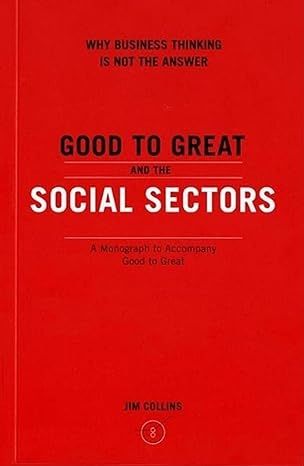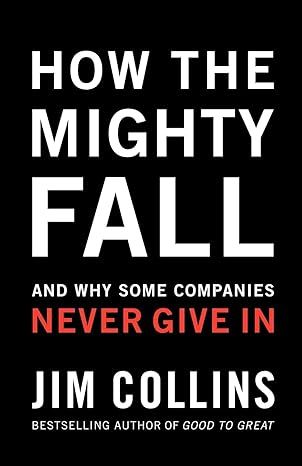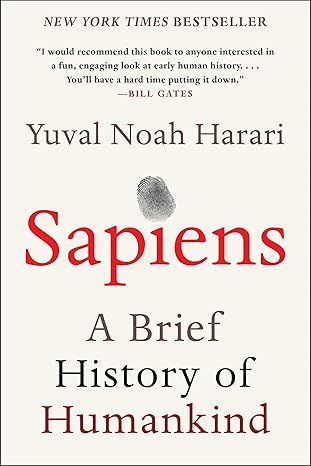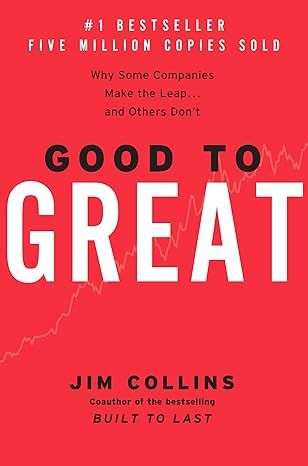Good to Great: Why Some Companies Make the Leap...And Others Don't (Good to Great, 1)
4.5
-
9,099 ratings
The Challenge:
Built to Last, the defining management study of the nineties, showed how great companies triumph over time and how long-term sustained performance can be engineered into the DNA of an enterprise from the verybeginning.
But what about the company that is not born with great DNA? How can good companies, mediocre companies, even bad companies achieve enduring greatness?
The Study:
For years, this question preyed on the mind of Jim Collins. Are there companies that defy gravity and convert long-term mediocrity or worse into long-term superiority? And if so, what are the universal distinguishing characteristics that cause a company to go from good to great?
The Standards:
Using tough benchmarks, Collins and his research team identified a set of elite companies that made the leap to great results and sustained those results for at least fifteen years. How great? After the leap, the good-to-great companies generated cumulative stock returns that beat the general stock market by an average of seven times in fifteen years, better than twice the results delivered by a composite index of the world's greatest companies, including Coca-Cola, Intel, General Electric, and Merck.
The Comparisons:
The research team contrasted the good-to-great companies with a carefully selected set of comparison companies that failed to make the leap from good to great. What was different? Why did one set of companies become truly great performers while the other set remained only good?
Over five years, the team analyzed the histories of all twenty-eight companies in the study. After sifting through mountains of data and thousands of pages of interviews, Collins and his crew discovered the key determinants of greatness -- why some companies make the leap and others don't.
The Findings:
The findings of the Good to Great study will surprise many readers and shed light on virtually every area of management strategy and practice. The findings include:
Level 5 Leaders: The research team was shocked to discover the type of leadership required to achieve greatness.
The Hedgehog Concept: (Simplicity within the Three Circles): To go from good to great requires transcending the curse of competence.
A Culture of Discipline: When you combine a culture of discipline with an ethic of entrepreneurship, you get the magical alchemy of great results. Technology Accelerators: Good-to-great companies think differently about the role of technology.
The Flywheel and the Doom Loop: Those who launch radical change programs and wrenching restructurings will almost certainly fail to make the leap.
“Some of the key concepts discerned in the study,” comments Jim Collins, "fly in the face of our modern business culture and will, quite frankly, upset some people.”
Perhaps, but who can afford to ignore these findings?
Read more
Kindle
$0.00
or $15.99 to buy
Audiobook
$0.99
with membership trial
Hardcover
$18.91
Audio CD
$5.88
Ships from
Amazon.com
Payment
Secure transaction
ISBN-10
0066620996
ISBN-13
978-0066620992
Print length
300 pages
Language
English
Publisher
Harper Business
Publication date
October 15, 2001
Dimensions
6.12 x 1.05 x 9.25 inches
Item weight
1.1 pounds
Popular Highlights in this book
Greatness is not a function of circumstance. Greatness, it turns out, is largely a matter of conscious choice.
Highlighted by 14,906 Kindle readers
The good-to-great companies did not focus principally on what to do to become great; they focused equally on what not to do and what to stop doing.
Highlighted by 12,935 Kindle readers
Practical Discipline #3: Put your best people on your biggest opportunities, not your biggest problems.
Highlighted by 11,043 Kindle readers
Practical Discipline #1: When in doubt, don’t hire—keep looking.
Highlighted by 10,342 Kindle readers
Product details
ASIN :
0066620996
File size :
9162 KB
Text-to-speech :
Enabled
Enhanced typesetting :
Enabled
X-Ray :
Enabled
Word wise :
Enabled
Editorial reviews
Amazon.com Review
Five years ago, Jim Collins asked the question, "Can a good company become a great company and if so, how?" In Good to Great Collins, the author of Built to Last, concludes that it is possible, but finds there are no silver bullets. Collins and his team of researchers began their quest by sorting through a list of 1,435 companies, looking for those that made substantial improvements in their performance over time. They finally settled on 11--including Fannie Mae, Gillette, Walgreens, and Wells Fargo--and discovered common traits that challenged many of the conventional notions of corporate success. Making the transition from good to great doesn't require a high-profile CEO, the latest technology, innovative change management, or even a fine-tuned business strategy. At the heart of those rare and truly great companies was a corporate culture that rigorously found and promoted disciplined people to think and act in a disciplined manner. Peppered with dozens of stories and examples from the great and not so great, the book offers a well-reasoned road map to excellence that any organization would do well to consider. Like Built to Last, Good to Great is one of those books that managers and CEOs will be reading and rereading for years to come. --Harry C. Edwards
From Publishers Weekly
In what Collins terms a prequel to the bestseller Built to Last he wrote with Jerry Porras, this worthwhile effort explores the way good organizations can be turned into ones that produce great, sustained results. To find the keys to greatness, Collins's 21-person research team (at his management research firm) read and coded 6,000 articles, generated more than 2,000 pages of interview transcripts and created 384 megabytes of computer data in a five-year project. That Collins is able to distill the findings into a cogent, well-argued and instructive guide is a testament to his writing skills. After establishing a definition of a good-to-great transition that involves a 10-year fallow period followed by 15 years of increased profits, Collins's crew combed through every company that has made the Fortune 500 (approximately 1,400) and found 11 that met their criteria, including Walgreens, Kimberly Clark and Circuit City. At the heart of the findings about these companies' stellar successes is what Collins calls the Hedgehog Concept, a product or service that leads a company to outshine all worldwide competitors, that drives a company's economic engine and that a company is passionate about. While the companies that achieved greatness were all in different industries, each engaged in versions of Collins's strategies. While some of the overall findings are counterintuitive (e.g., the most effective leaders are humble and strong-willed rather than outgoing), many of Collins's perspectives on running a business are amazingly simple and commonsense. This is not to suggest, however, that executives at all levels wouldn't benefit from reading this book; after all, only 11 companies managed to figure out how to change their B grade to an A on their own. Copyright 2001 Cahners Business Information, Inc.
From Booklist
Collins is coauthor of Built to Last: Successful Habits of Visionary Companies (1994), the widely heralded book that was the result of a six-year research project conducted by Collins and Jerry Porras. They identified 18 companies that met their rigorous standard for long-term performance. They looked for companies that had outperformed the stock market by a factor of 15 starting from 1926. Then they went about the task of identifying what these companies had in common. Now Collins turns his attention to companies that have made the transition from "good to great." This time the findings are backed by five years of research and data analysis. Starting with every company that ever appeared in the Fortune 500, Collins identifies 11 companies that had 15-year cumulative stock returns at or below the general stock market when, after a transition point, they then demonstrated cumulative returns of at least three times the market over the next 15 years. Collins then looked for similarities among the companies. What he found would both surprise and fascinate anyone involved in management. David Rouse Copyright © American Library Association. All rights reserved
Review
One of the top ten business books of 2001 — Business Week
From the Back Cover
The Challenge Built to Last, the defining management study of the nineties, showed how great companies triumph over time and how long-term sustained performance can be engineered into the DNA of an enterprise from the very beginning. But what about the company that is not born with great DNA? How can good companies, mediocre companies, even bad companies achieve enduring greatness? The Study
For years, this question preyed on the mind of Jim Collins. Are there companies that defy gravity and convert long-term mediocrity or worse into long-term superiority? And if so, what are the universal distinguishing characteristics that cause a company to go from good to great? The Standards
Using tough benchmarks, Collins and his research team identified a set of elite companies that made the leap to great results and sustained those results for at least fifteen years. How great? After the leap, the good-to-great companies generated cumulative stock returns that beat the general stock market by an average of seven times in fifteen years, better than twice the results delivered by a composite index of the world's greatest companies, including Coca-Cola, Intel, General Electric, and Merck.The Comparisons
The research team contrasted the good-to-great companies with a carefully selected set of comparison companies that failed to make the leap from good to great. What was different? Why did one set of companies become truly great performers while the other set remained only good? Over five years, the team analyzed the histories of all twenty-eight companies in the study. After sifting through mountains of data and thousands of pages of interviews, Collins and his crew discovered the key determinants of greatness -- why some companies make the leap and others don't. The Findings
The findings of the Good to Great study will surprise many readers and shed light on virtually every area of management strategy and practice. The findings include:Level 5 Leaders: The research team was shocked to discover the type of leadership required to achieve greatness.The Hedgehog Concept (Simplicity within the Three Circles): To go from good to great requires transcending the curse of competence.A Culture of Discipline: When you combine a culture of discipline with an ethic of entrepreneurship, you get the magical alchemy of great results. Technology Accelerators: Good-to-great companies think differently about the role of technology.The Flywheel and the Doom Loop: Those who launch radical change programs and wrenching restructurings will almost certainly fail to make the leap.“Some of the key concepts discerned in the study,” comments Jim Collins, "fly in the face of our modern business culture and will, quite frankly, upset some people.” Perhaps, but who can afford to ignore these findings?
About the Author
Jim Collins is a student and teacher of what makes great companies tick, and a Socratic advisor to leaders in the business and social sectors. Having invested more than a quarter-century in rigorous research, he has authored or coauthored six books that have sold in total more than 10 million copies worldwide. They include Good to Great, Built to Last, How the Mighty Fall, and Great by Choice.Driven by a relentless curiosity, Jim began his research and teaching career on the faculty at the Stanford Graduate School of Business, where he received the Distinguished Teaching Award in 1992. In 1995, he founded a management laboratory in Boulder, Colorado.In addition to his work in the business sector, Jim has a passion for learning and teaching in the social sectors, including education, healthcare, government, faith-based organizations, social ventures, and cause-driven nonprofits.In 2012 and 2013, he had the honor to serve a two-year appointment as the Class of 1951 Chair for the Study of Leadership at the United States Military Academy at West Point. In 2017, Forbes selected Jim as one of the 100 Greatest Living Business Minds.Jim has been an avid rock climber for more than forty years and has completed single-day ascents of El Capitan and Half Dome in Yosemite Valley.Learn more about Jim and his concepts at his website, where you’ll find articles, videos, and useful tools. jimcollins.com
Read more
About the authors
Jim Collins
Jim Collins is a student and teacher of what makes great companies tick, and a Socratic advisor to leaders in the business and social sectors. Having invested more than a quarter century in rigorous research, he has authored or coauthored a series of books that have sold in total more than 10 million copies worldwide. They include Good to Great, the #1 bestseller, which examines why some companies make the leap and others don’t; the enduring classic Built to Last, which discovers why some companies remain visionary for generations; How the Mighty Fall, which delves into how once-great companies can self-destruct; and Great by Choice, which uncovers the leadership behaviors for thriving in chaos and uncertainty. Jim has also published two monographs that extend the ideas in his primary books: Good to Great and the Social Sectors and Turning the Flywheel.
His most recent publication is BE 2.0 (Beyond Entrepreneurship 2.0), an ambitious upgrade of his very first book; it returns Jim to his original focus on small, entrepreneurial companies and honors his coauthor and mentor Bill Lazier.
Driven by a relentless curiosity, Jim began his research and teaching career on the faculty at the Stanford Graduate School of Business, where he received the Distinguished Teaching Award in 1992. In 1995, he founded a management laboratory in Boulder, Colorado, where he conducts research and engages with CEOs and senior-leadership teams.
In addition to his work in the business sector, Jim has a passion for learning and teaching in the social sectors, including education, healthcare, government, faith-based organizations, social ventures, and cause-driven nonprofits. In 2012 and 2013, he had the honor to serve a two-year appointment as the Class of 1951 Chair for the Study of Leadership at the United States Military Academy at West Point.
Jim holds a bachelor's degree in mathematical sciences and an MBA from Stanford University, and honorary doctoral degrees from the University of Colorado and the Peter F. Drucker Graduate School of Management at Claremont Graduate University. In 2017, Forbes selected Jim as one of the 100 Greatest Living Business Minds.
Read more
Reviews
Customer reviews
4.5 out of 5
9,099 global ratings
Nick Rayson
5
... Collins utilized a systematic and technical approach to uncover good to great companies while at the same time providing ...
Reviewed in the United States on May 17, 2016
Verified Purchase
Jim Collins utilized a systematic and technical approach to uncover good to great companies while at the same time providing the reader with an easy to understand explanation of how others failed to make the giant leap. As one follows Collins logic through the build up to breakthrough flywheel, a framework of key concepts emerges illustrating the correlation of specific factors that play a key role in making a company great. The ability of a mediocre company to evolve into a great company requires strict discipline. Good to Great explains in detail how specific disciplines pushed companies to rocket off the charts from the point of their actual transition. A couple of these concepts developed by Jim Collins really stuck out their head as I dug deeper into the book. “Level 5 leaders are a study in duality: modest and willful, humble and fearless”
- Jim Collins
Level five leaders are at the forefront of making a company great. Collins breaks down some assumptions and beliefs about what makes a CEO “great.” All good to great companies had level 5 leaders based on consistent patterns within the research data. He asks the question, “Does it take a larger than life leader that makes more money than you can imagine, to create greatness?” The simple answer is no. Rather, it takes a CEO born from within the company like, Colman Mockler, CEO of Gillete from 1975 to 1991, in order to get the job done for example. Mocklers understated presence as CEO, will to endure, and refusal to cash in when the going gets tough, based on Collins definition, is a level 5 leader. The concept of this level of leadership gives great insight into what current and future mangers of a company should strive to be. “They stick with what they understand and let their abilities, not their egos, determine what they attempt”
- Warren Buffet
Another compelling concept developed while in the process of defining what takes a company from good to great is the Hedgehog Concept. This concept, as Collins describes, is one dependent on asking yourself three, what seem to be simple at first, questions about yourself and your company. What can you be the best in the world at, what drives your economic engine, and what are you deeply passionate about? These questions are known as the three circles. More importantly, the good to great companies analyzed in Collins research, were not the best at anything before hitting their point of transition, but were fully aware of what they could be the best at, and drove hard at their strengths to achieve such greatness. Defining realistic objectives and goals, finding your economic engine, and finding your passion are realized while implementing Collins Hedgehog Concept. Good to Great by Jim Collins is a fascinating read not for its technicality or empirical evidence in justifying what makes a company great, it is fascinating in its simplicity. Stepping back and really taking a disciplined approach to management seems obvious and yet your compelled to read every last word within the book. As I read deeper, it became clearer that the given comparisons of large fortune 500 companies are less about a company being great at one point in time, and more about the timeless principles of discipline that sustain greatness. My personal takeaway from this book is, complacency is the root of mediocrity, and mediocrity slowly kills greatness before it even has a chance to grow. I would recommend Good to Great, by Jim Collins, not only for managers but for anyone that wants to achieve their goals with the help of a proven framework.
Read more
M.Murphy50
5
SO Insightful
Reviewed in the United States on August 2, 2024
Verified Purchase
I have to admit that I was skeptical at first about how a book about big companies moving from good to great would apply to my entrepreneurial endeavor. But, at the recommendation from a business man I greatly admire, I read the book and I am SO glad I did. As I read I started thinking and applying what I was reading to my own enterprise. I believe this book has helped me clarify where I need to focus and the steps to take to build my own great enterprise!
Read more
Magnus
5
enlightening and profound
Reviewed in the United States on September 23, 2024
Verified Purchase
This was my second read of the book and i still cherish every ideas highlighted in the book. Packed in simple anecdotes the ideas are easy to understand, but takes time and energy to apply it
BJHarris
5
GOOD to GREAT...Highly Recommend
Reviewed in the United States on June 7, 2013
Verified Purchase
Jim Collins states in his book, "Good is the enemy of great. And that is one of the key reasons why we have so little that become great...We believe that almost any organization can substantially improve its stature and performance, perhaps even become great, if it conscientiously applies the frame work of ideas we've uncovered." After reading that statement I became very curious and wanting to continue reading to see what are the components that make a good company to be a great company, in hopes of maybe being apply it myself one day I really enjoyed the way in which Collins organized the book. From his five year research study of 28 different companies Good to Great discusses key critical concepts revealed through his studies as to why some companies became successful great companies, while the others continued to be good. Collins found from his research within a great company you will have discipline people, with discipline thought, drives discipline actions. Within each discipline it is broken down into a subset of two components: I. Discipline People a. Level 5 Leadership b. First Who... Then What II. Discipline Thought a. Confront the Brutal facts b. Hedgehog Concepts III. Discipline Action a. Culture of Discipline b. Technology Accelerators I believe by organizing the book in this matter enabled me to really understand the severity of the critical components and how their relationships if applied will in allow a good company to become a great company. Starting with Discipline People, Collins conducted and analyzed his research by introducing the types of leaders you would find in a great company versus those in a just a good company and the characteristics that these great leaders possessed, such as humility and will. They lead with the interest of the company and not for their own selfish reasoning. Next was the First Who ...Then what which discuss getting the right people on board and the wrong people out. Collins states, "People are not your most important assets. The right people are." Collins stresses the importance of first getting the right people in the right places in your company and weeding out the wrong and then figure out where your company wants to go. Next is the Discipline Thought, within the subset of discipline thought a company must possess the ability to confront the brutal facts and not live in denial. Being able to do this will allow the company to stay updated and proactive when faced with making decisions. Collins presented a methodology for the companies to be able to face the truth. He says an organization must lead with questions not answers, engage in dialogue and debate, and use the "red flag mechanism" where anything that is red flagged is information that cannot be ignored and must be handled immediately. Collins also mentioned under the category of discipline thought is the Hedgehog Concept. The Hedgehog Concept is about a Fox and Hedgehog, where the Fox (good companies) knows a lot about variety of things whereas the Hedgehog (great companies) knew a lot about one thing. Being hedgehog is more beneficial for both the company and the individual because it the clarity drives focus and direction whereas the fox has neither one direction nor focus which can backfire later down the road. Lastly, having discipline people with discipline thoughts will drive to discipline action which uses the culture of discipline and technology as another tool to help transform the company from good to great. Collins also refers to the Flywheel Concept. He says that a good to great company never happens all at once it take a lot of effort and time to get it going, like the flywheel. The flywheel requires a lot of pushing to get it to turn and after x amount of time it will begin to gain momentum. Throughout the book Collins gives great examples for each discipline and its component and how it either went from good to great or continued to be good. Along with the examples Collins provides pleather of diagrams and charts in the appendix, which becomes a great reference for the reader and creates a better understanding of what is needed to go from a good company to a great company. Generally the book is a very easy read which makes it that much more interesting to want to apply to your company or even for yourself. It takes the feeling of the impossible away, like Collin stated, "We believe that almost any organization can substantially improve its stature and performance, perhaps even become great, if it conscientiously applies the frame work of ideas we've uncovered." Overall if you are looking to transform your company, Good to Great is a read that I highly recommend.
Read more
14 people found this helpful
Lonnie E. Holder
5
Observations of Good Companies that Transitioned to Great
Reviewed in the United States on September 23, 2004
Verified Purchase
In reading the reviews of this book you will likely think that either this book is a piece of trash, or a road map to being the greatest company on earth. However, this book is neither. What Jim Collins and his staff of researchers did was to analyze 1,435 companies that had appeared in the Fortune 500 to find 11 companies with a specific set of characteristics. A couple of the most key characteristics were that these companies had to have been good performers for a number of years and then gone through a transition phase where they achieved well above industry average in performance sustained for at least 15 years.
Once these 11 companies were chosen along with comparison companies, Jim Collins and his research team looked for common characteristics between these companies. What they believe they found they defined as: having level 5 leadership; having the right people in the company; confronting the brutal facts of their situation; defining what a company is good at; discipline; and the flywheel effect. Collins also discusses the role of technology with an interesting conclusion. While you could likely have guessed some of what they found, Collin's assertion is that a company that has transitioned from good to great and sustained that performance would have each of these characteristics.
What makes this book a great read? The support Collins provides for his conclusions. Collins rigorously assembled facts and then attempted to infer the common factors between the selected companies. While you may argue whether the selected companies will be great in the future, or whether other great companies exist that also made a good to great transition, the fact remains that he and his team did not waver in their criteria and they were able to observe the common characteristics that are described in this book.
The greatest difficulty with the book is that it does not provide a roadmap for any particular company to make the transition. The reader is left to determine how his company might be able to achieve the characteristics of a good-to-great company, or perhaps, how to eliminate the characteristics of a company that would prevent the company from being great, or perhaps even good. One general point of agreement is that each of the defined characteristics is worthy of achieving.
There are a few weaknesses in book. One question that we asked (the leadership team of my company) was whether level 5 leadership could exist with second tier management and not with the top leader. Collins seemed to think that the top leader in the company needed to be a level 5 leader, but we thought that a level 4 leader with a strong level 5 leadership at the second tier could well accomplish the same goal. We also looked at the recent stock market performance of the 11 companies chosen and discovered that more recently some of these companies had performed very poorly. We believe that an effective follow up to this book would be an analysis of companies that went from good to great to good or less than good to see whether a failure in one of the identified factors was the cause of the drop.
This book offers a lot of thought-provoking information. It is a widely-read book because of the methodology Collins used in his data collection. It helps that this book is well-written and a quick read. Neither makes this book a perfect business book, but certainly the conclusions should make us all consider how we can make our companies better. An excellent companion book to "Built to Last."
Read more
23 people found this helpful
Top Jim Collins titles
View all
Good to Great and the Social Sectors: A Monograph to Accompany Good to Great (Good to Great, 3)
4.5
-
1,474
$6.00

Turning the Flywheel: A Monograph to Accompany Good to Great
4.6
-
1,230
$0.99

How The Mighty Fall
4.6
-
1,081
$0.99

BE 2.0 (Beyond Entrepreneurship 2.0): Turning Your Business into an Enduring Great Company
4.8
-
803
$0.99

Great by Choice: Uncertainty, Chaos and Luck - Why Some Thrive Despite Them All
4.6
-
1,765
$0.99
Best Sellers
View all
The Tuscan Child
4.2
-
100,022
$8.39

The Thursday Murder Club: A Novel (A Thursday Murder Club Mystery)
4.3
-
155,575
$6.33

Sapiens: A Brief History of Humankind
4.6
-
140,302
$13.49

The Butterfly Garden (The Collector, 1)
4.3
-
88,556
$9.59

Things We Hide from the Light (Knockemout Series, 2)
4.4
-
94,890
$11.66

The Last Thing He Told Me: A Novel
4.3
-
154,085
$2.99

The Perfect Marriage: A Completely Gripping Psychological Suspense
4.3
-
143,196
$9.47

The Coworker
4.1
-
80,003
$13.48

First Lie Wins: A Novel (Random House Large Print)
4.3
-
54,062
$14.99

Mile High (Windy City Series Book 1)
4.4
-
59,745
$16.19

Layla
4.2
-
107,613
$8.99

The Locked Door
4.4
-
94,673
$8.53

